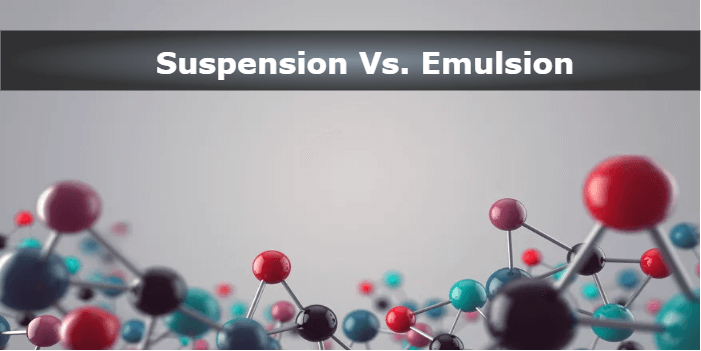Difference between Suspension and EmulsionSuspensions and Emulsions are two types of heterogeneous mixtures that are commonly used in a wide range of applications. They differ in terms of the nature of their components and the way they are mixed together. Understanding the differences between these two types of mixtures is important in many industries, including food, pharmaceuticals, and cosmetics, among others. In this article, we will explore the key differences between suspensions and emulsions. 
What is Suspension?One kind of heterogeneous mixture is a suspension, which consists of solid particles scattered throughout a liquid medium. The solid particles are usually visible to the naked eye and can settle over time due to gravity. Unlike solutions, the particles in a suspension do not dissolve in the liquid but are held in suspension by the liquid. Suspensions can be created by adding a solid to a liquid and stirring the mixture vigorously, which causes the particles to disperse throughout the liquid. The stability of a suspension depends on the size and density of the solid particles, as well as the viscosity of the liquid medium. Larger and denser particles are more likely to settle out of the mixture, while a more viscous liquid can help keep the particles suspended. Suspensions have a wide range of applications in various industries, including pharmaceuticals, where drugs are suspended in a liquid for oral or intravenous delivery. In the food business, they are also employed to produce goods like sauces and salad dressings. By varying the concentration or size of the solid particles as well as the viscosity of the liquid medium, the characteristics of a suspension may be altered. This makes suspensions a versatile tool for scientists and engineers who need to create stable mixtures of solids and liquids for a variety of purposes. Suspensions can be separated from the liquid by physical means such as filtration or centrifugation. Filtration is the process of passing the mixture through a filter that traps the solid particles and allows the liquid to pass through. Centrifugation involves spinning the mixture at high speeds, which causes the solid particles to settle at the bottom of the container, where they can be removed from the liquid. The separation method used depends on the size and density of the solid particles, as well as the desired purity of the liquid. What is Emulsion?An emulsion is a type of heterogeneous mixture that consists of two immiscible liquids, such as oil and water, that are mixed together with the help of an emulsifying agent. The emulsifying agent helps to break up the larger droplets of one liquid into smaller droplets that are more evenly dispersed throughout the other liquid. Emulsions are usually translucent or transparent and cannot be seen with the naked eye. Emulsions have a wide range of applications in various industries, including cosmetics, where oil and water-based ingredients need to be mixed together to create creams or lotions. They are also employed in the food business to produce items like milk and mayonnaise. By altering the kind and concentration of the emulsifying agent as well as the proportion of the two liquids, the characteristics of an emulsion may be changed. Emulsions can be unstable and can separate over time, which is known as phase separation. This can occur due to changes in temperature, pH, or the addition of other ingredients. In order to prevent phase separation, stabilizers may be added to the emulsion. Stabilizers help to maintain the emulsion by forming a protective barrier around the droplets, preventing them from coalescing and separating. Emulsions can be categorized into two types: oil-in-water (O/W) emulsions and water-in-oil (W/O) emulsions. In an O/W emulsion, oil is dispersed as small droplets throughout the water, while in a W/O emulsion, water is dispersed as small droplets throughout the oil. Difference between Suspension and EmulsionLet us now find out the differences between suspension and emulsion with the help of the following table:
ConclusionIn conclusion, suspensions and emulsions are two different types of heterogeneous mixtures. Suspensions consist of solid particles dispersed throughout a liquid, while emulsions consist of two immiscible liquids mixed together with the help of an emulsifying agent. Suspensions have visible, larger particles that can settle over time due to gravity, while emulsions have small, not visible particles that can separate over time due to instability. The preparation methods, examples, and separation methods for suspensions and emulsions also differ. Understanding the differences between these two types of mixtures is important for various industries that use them in different applications.
Next TopicDifference between
|
 For Videos Join Our Youtube Channel: Join Now
For Videos Join Our Youtube Channel: Join Now
Feedback
- Send your Feedback to [email protected]
Help Others, Please Share










